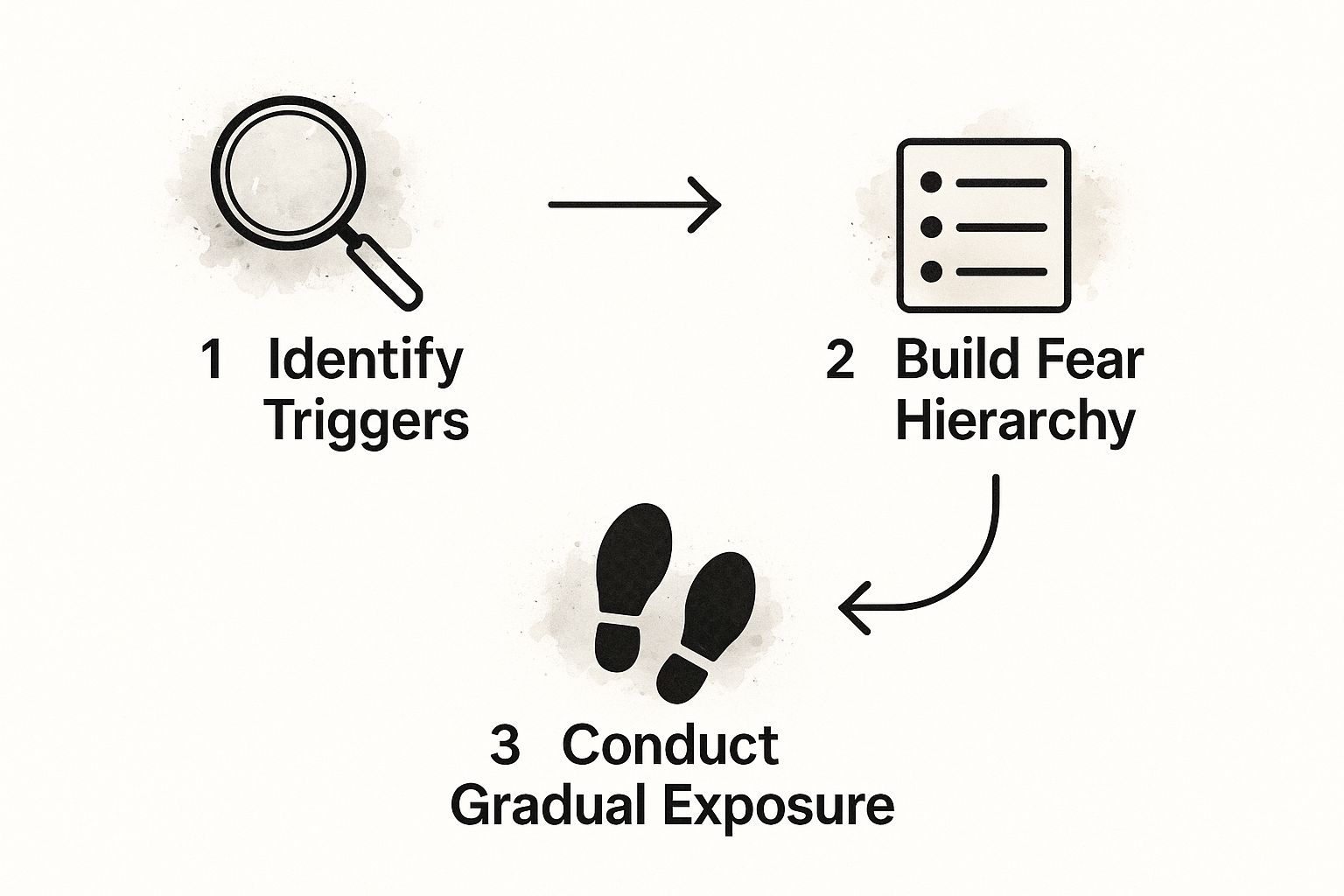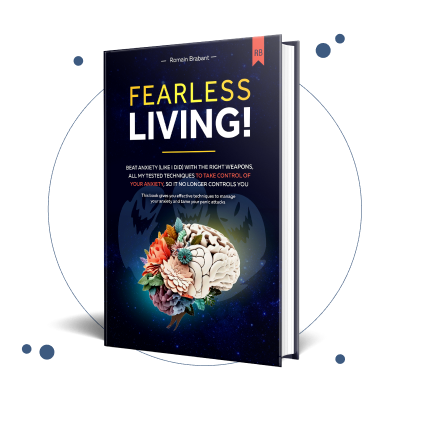
Exposure therapy is a powerful, science-backed approach designed to help you face your fears in a safe, controlled way. Instead of running from what scares you, this method guides you to gradually confront feared objects, situations, or even memories, stripping them of their power and giving you back your freedom.
Your Path to a Panic-Free Life Begins Here

This is where you start your journey toward a life with less anxiety and more peace. Think of exposure therapy not as being thrown into the deep end, but as slowly wading into the water with an expert guide right beside you. It’s a supportive process built to break the exhausting cycle of fear and avoidance, showing you a clear path to healing.
The core idea is simple but incredibly effective. By systematically facing what you fear, you learn two critical things: the anxiety you feel will eventually fade on its own, and the terrible outcomes you imagine almost never happen. This isn’t just a theory; it's a proven method, backed by decades of research, that puts you back in the driver's seat of your life.
This process demonstrates that you are capable of managing your fear. It recalibrates your brain’s alarm system, showing it that you can handle challenging situations, which builds lasting confidence and the hope for a calmer future.
Building a Foundation for Hope
The ultimate goal here is to restore freedom and possibility to your world. It's a hands-on, action-oriented therapy that gives you the tools to stop living a life dictated by "what ifs." Most importantly, the process is always collaborative, ensuring you feel secure every step of the way. You set the pace, you define the goals, and you discover your own incredible strength.
This introduction is meant to be encouraging because healing isn't just possible—it's within your reach. Understanding the fundamental anxiety recovery steps is a key part of this journey. The very first step is believing that a life without panic is achievable for you.
The Science of Facing Your Fears Safely
At its heart, exposure therapy runs on a simple but powerful idea: avoidance fuels fear, while safe exposure dissolves it. Every time you dodge a situation that makes you anxious, you're essentially telling your brain, "See? That was dangerous. Good thing we avoided it." This might bring a wave of relief in the moment, but over time, it only reinforces the fear and can make your world feel smaller and smaller.
Exposure therapy is all about gently turning that ship around and sailing toward a brighter horizon. It’s a method steeped in decades of behavioral psychology, with roots reaching all the way back to the early 1900s. Experiments in the 1920s first showed that learned fears could be unlearned through gradual exposure. By the 1950s, therapists began shaping this concept into a structured, reliable treatment, forever changing how we approach anxiety. You can read more about the fascinating history of exposure therapy and its development to see how it evolved.
The entire process is designed to systematically teach your brain a new, more accurate story—that the things you've been dreading are not the catastrophes your anxiety has made them out to be, and that you have the power to overcome them.
How Your Brain Learns to Let Go
The magic behind exposure therapy is a process called habituation. It’s something you experience all the time without even thinking about it.
Imagine a new air freshener in your car. For the first day, the scent is all you can smell. But by the third day? You barely notice it. Your brain has learned the smell isn’t a threat and has started to tune it out. That's habituation.
Exposure therapy applies this same natural process to your fears. By repeatedly and safely facing something that triggers your anxiety—without anything bad actually happening—your brain’s internal alarm system slowly starts to power down. That familiar jolt of adrenaline and the intense physical reaction begin to soften with each new exposure, bringing a sense of calm.
This isn’t just a mind game; it’s your biology recalibrating for peace. Your nervous system learns that the trigger is a false alarm. The key is to stay with the feeling long enough for your anxiety to rise, peak, and then fall naturally on its own.
By experiencing this decrease in fear without resorting to escape or avoidance, you build profound, lasting confidence. You learn from direct experience that you can handle the discomfort and that the feeling of panic will not last forever.
This process helps retrain the body’s built-in alarm system. Getting a handle on how this system works is a huge part of recovery, and you can learn more in our complete guide to the fight-or-flight response.
Ultimately, exposure therapy rewires your fear response. It shows you, through your own experience, that you have the strength to stay calm and in control, even when facing what once felt completely unbearable.
Finding the Right Therapeutic Approach for You

One of the biggest misconceptions about exposure therapy is that it's a rigid, one-size-fits-all process. Nothing could be further from the truth. Think of it less like a strict prescription and more like a flexible toolkit designed for your healing. You and your therapist work together to pick the right tools for your specific needs, always making sure you feel safe and in control.
This partnership is what makes the process so effective and hopeful. Because everyone’s experience with anxiety is unique, the path to healing has to be, too. The right approach for you depends entirely on what you're facing, what feels manageable, and what will genuinely help you reclaim your life from fear.
Common Types of Exposure
Your therapist will walk you through several well-established methods. Each one offers a different way to face your fears in a structured, step-by-step manner, building your confidence along the way toward a more peaceful life.
Here are the main types you’ll likely discuss:
-
In Vivo Exposure: This is the most direct approach—facing your fear in a real-life situation. If you have a phobia of dogs, you wouldn't start by visiting a dog park. Instead, you might begin by looking at photos, then progress to watching a dog from across the street, and eventually work your way up to petting a calm, friendly dog with your therapist by your side. It's all about small, manageable steps that lead to big victories.
-
Imaginal Exposure: Sometimes, it’s just not practical or even possible to confront a fear directly, especially when healing from traumatic memories or deep-seated worries. This is where imaginal exposure comes in. In the safety of a therapy session, you’ll be guided to vividly imagine the feared situation or memory, describing it out loud in detail until the anxiety it triggers starts to lose its power.
-
Virtual Reality (VR) Exposure: Technology has given us an incredible middle ground between imagination and reality. VR exposure uses realistic simulations to create immersive experiences in a completely controlled setting. Someone with a fear of flying can "board" a plane, feel the rumble of takeoff, and even experience turbulence, all without ever leaving the therapist's office.
A core principle of exposure therapy is that it’s always gradual and collaborative. You will never be pushed into a situation you aren't ready to handle. Your therapist is there as your guide, supporting you as you move at a pace that feels right for you.
Comparing Types of Exposure Therapy
To help clarify which approach might fit best, let's look at them side-by-side. Your therapist will help you decide, but understanding the options can be an empowering first step toward hope.
| Therapy Type | Description | Best For |
|---|---|---|
| In Vivo Exposure | Directly confronting a feared object, situation, or activity in real life. | Specific phobias (e.g., heights, spiders, driving), social anxiety. |
| Imaginal Exposure | Vividly imagining the feared situation, thought, or memory. | Post-Traumatic Stress Disorder (PTSD), anxiety where direct exposure isn't possible. |
| Virtual Reality (VR) | Using technology to simulate a feared scenario in a controlled environment. | Fear of flying, public speaking, combat-related PTSD, complex phobias. |
Each method has its place, and sometimes a therapist might even blend approaches to create a plan that’s perfectly suited to your journey of healing.
Specialized Methods for Specific Needs
Beyond these foundational types, therapists also use more specialized approaches for certain conditions. Perhaps the most well-known is Exposure and Response Prevention (ERP), which is considered the gold-standard treatment for Obsessive-Compulsive Disorder (OCD).
ERP is a two-part process. First comes the exposure, where you intentionally encounter a thought or situation that triggers your obsessions. Then comes the response prevention, where you actively resist the urge to perform your usual compulsion or ritual.
For instance, someone with a fear of contamination might be asked to touch a doorknob (exposure) and then refrain from washing their hands for a set amount of time (response prevention). This powerful process directly challenges the OCD cycle, teaching your brain that you can, in fact, tolerate the anxiety without needing the ritual for relief.
Getting to know the different options available in psychotherapy for anxiety is a massive first step. It proves there isn’t just one path to healing—there are many. A qualified professional can help you find the one that leads you toward a life with less fear and more freedom.
Your Step-by-Step Journey to a Calmer Life
Thinking about starting therapy can feel overwhelming, but the actual process is far more structured and collaborative than most people realize. It’s a partnership from day one, built on trust and designed to create a clear, personalized roadmap where you are always in the driver's seat. The goal is to move forward with intention, not pressure, toward a life you love.
It all starts with an assessment, which is really just a conversation for you and your therapist to get to know each other. This is your chance to share your story in a safe, non-judgmental space. Together, you’ll start to connect the dots and identify the specific fears and avoidance patterns that are holding you back from living fully.
Creating Your Personalized Roadmap to Freedom
Next, you'll work together to build a fear ladder (sometimes called an exposure hierarchy). Think of this as your personalized guide to getting unstuck and reclaiming your peace. It’s simply a list of situations, activities, or thoughts tied to your fear, ranked from the least scary to the most challenging.
This isn't about jumping into the deep end. Not at all. It’s about breaking down a huge fear into small, manageable steps that actually feel doable. Each rung on the ladder is a specific challenge you'll tackle, building real confidence with every single win.
For someone working to overcome social anxiety, a fear ladder might look something like this:
- Step 1: Make eye contact with a cashier at the grocery store.
- Step 2: Ask a stranger on the street for the time.
- Step 3: Have a brief, five-minute chat with a coworker in the breakroom.
- Step 4: Stay at a small social gathering for at least 30 minutes.
Each step is a concrete victory that builds momentum. More importantly, it proves to you that you can handle way more than your anxiety claims you can.

As you can see, the process is logical and incremental. It’s all about moving from understanding your fears to systematically and gently facing them, with hope as your guide.
Taking the First Steps with Support
With your fear ladder in hand, it's time to begin the gradual exposure exercises. You always start at the bottom with the least intimidating challenge first. You and your therapist decide the pace together, and you will never, ever be pushed to do something you haven’t agreed to.
During these exposures, you’ll also learn crucial coping skills. Mastering a few simple tools can make all the difference. For instance, our guide on breathing exercises for anxiety details techniques you can use to stay grounded when you feel overwhelmed. Your therapist will make sure you feel prepared and equipped for each step.
The whole point of each exposure is to let yourself feel the anxiety without running away. You stay with the feeling just long enough to learn two things: your fear naturally fades on its own, and the catastrophic thing you dread doesn't actually happen.
This firsthand experience is incredibly powerful. It’s undeniable proof that you are resilient and capable. Each completed step helps rewire your brain’s response, slowly but surely chipping away at the anxiety until it no longer has control. This step-by-step approach makes recovery feel real and achievable, lighting up a clear path toward a life with less panic.
How Exposure Therapy Heals Trauma and PTSD

When you’re carrying the weight of trauma, finding a way forward can feel like an impossible task. But there is so much hope. A specific, highly structured therapy called Prolonged Exposure (PE) is designed to do just that, and it directly tackles the painful heart of Post-Traumatic Stress Disorder (PTSD).
PE works by creating a safe, controlled environment where you can finally process traumatic memories that feel too overwhelming to face on your own. Instead of continuing to push those memories away—a tactic that only makes them stronger—this therapy guides you to gently approach them. Slowly but surely, this process starts to strip away their intense emotional power, giving you the freedom to heal and move forward.
The goal isn’t to erase the memory; it's to fundamentally change your relationship with it. PE helps you learn that while the memories and reminders are painful, they are not actually dangerous here and now. That shift in perspective is a massive step toward living a peaceful life.
A Proven Path to Recovery
Developed back in the 1980s by Dr. Edna Foa and her team, Prolonged Exposure Therapy wasn’t just a new idea—it was built on a mountain of research into treating PTSD. It has since become a gold-standard treatment, backed by more than 40 randomized clinical trials around the world. This wealth of evidence confirms its effectiveness for everyone from veterans to assault survivors and anyone else impacted by a traumatic event. You can dig into the extensive scientific support for Prolonged Exposure Therapy to learn more.
The therapy itself is built on two core pillars of healing:
- Imaginal Exposure: This involves revisiting the traumatic memory in your mind's eye and describing it out loud in the present tense. By repeating this in a safe setting, the memory gradually loses its ability to trigger overwhelming distress.
- In Vivo Exposure: This means "in real life." You'll slowly and safely re-engage with the situations, places, or people you've been avoiding because they remind you of the trauma.
This two-pronged approach systematically breaks down the cycle of avoidance that keeps PTSD going. It puts you back in the driver's seat by proving that you can handle both the memories themselves and the real-world reminders.
Sometimes, understanding the deeper roots of trauma is also a critical piece of the puzzle. For more context on how these patterns can form, you might find it helpful to read our piece on how generational trauma contributes to anxiety. At its core, PE offers a clear, evidence-based roadmap to recovery, proving that even the deepest wounds can begin to heal with the right guidance and support.
Taking the First Step Toward a Panic-Free Life
Knowing what exposure therapy is and actually deciding to do it are two very different things. It’s completely normal to feel a mix of hope and, let's be honest, a good bit of fear. But what’s waiting on the other side isn't just about managing anxiety—it’s about getting your life back. It's about being able to say "yes" to things you've been missing out on, instead of letting fear make the decisions for you.
The rewards here go so much deeper than just feeling less scared. With every small step you take, you're not just facing a fear; you're building real, solid self-trust. You're proving to yourself, over and over, that you can handle more than your anxiety lets you believe, and that feeling starts to bleed into every other part of your life. You’re essentially rewriting your own story, shifting the narrative from one of fear to one of empowerment and hope.
Finding a Guide You Can Trust
A lot of people worry that the therapy itself will be too much to handle. That’s a valid concern, and it’s precisely why having a skilled and compassionate therapist is so important. Their main job is to create a safe environment where you are always in the driver's seat. They aren't there to push you off a cliff; they’re there to walk alongside you, at your pace, on your journey to healing.
A great therapeutic relationship is a partnership. It’s built on trust, collaboration, and a feeling that you’re on the same team. You need to feel heard, understood, and confident that they know what they’re doing.
So, how do you find that person?
- Look for Specialists: Search for therapists who specialize in Cognitive Behavioral Therapy (CBT) and, more specifically, have hands-on training in using exposure for anxiety, phobias, or PTSD. This isn't a place for generalists.
- Ask the Right Questions: When you have a consultation call, don't be shy. Ask about their experience with cases like yours, how they approach creating an exposure hierarchy, and what they do to make sure their clients feel safe and in control.
- Trust Your Gut: You can’t fake a good connection. You should walk away from that first conversation feeling a sense of rapport and thinking, "Okay, I could work with this person."
A life unconstrained by fear isn’t just a nice idea—it is a real and achievable goal. The path takes courage, but you don't have to walk it alone.
Deciding to take action is the most powerful move you can make. It’s a profound act of hope and a clear signal that you’re ready to start building a panic-free life.
Got Questions? Let's Talk About Exposure Therapy
It’s completely normal to have questions and even a little apprehension when you're thinking about a new type of therapy. Honestly, it's a good thing—it means you're taking your well-being seriously. Feeling empowered starts with understanding the process, so let's clear up some of the most common questions people have.
Is This Actually Safe?
Absolutely, yes. When exposure therapy is done correctly with a trained professional, it's incredibly safe. The whole point is to put you in the driver's seat. You and your therapist work together to map out every single step. You never jump into the deep end; instead, you only move forward when you genuinely feel ready.
A good therapist's job is to find that sweet spot—challenging you just enough to grow, but never, ever pushing you past your breaking point. You are always in control.
How Long Until I See a Difference?
While everyone’s journey is different, exposure therapy is considered a short-term approach. Many people start to feel a real, lasting shift in just 8 to 16 sessions. It's not a forever-and-ever kind of therapy.
The goal isn't just to get you through a few tough situations. It's about teaching you a new way of responding to fear so you can take those skills with you for the rest of your life, long after your sessions are over.
The real power of this therapy is that it doesn’t just help you feel better in the moment; it gives you the tools to become your own therapist over time.
Will I Be Forced to Do Something Terrifying?
Let's get this one out of the way: you will never be forced to do anything you don't agree to. This is a partnership, not a boot camp. You set the pace.
Yes, the idea is to face things that scare you, but you'll do it in small, manageable steps that you and your therapist decide on together. The whole point is to build up your confidence and help you see just how capable you really are, not to throw you into a needlessly stressful situation.
This journey is about showing you that a life free from panic isn't just a nice idea—it's completely within your reach.
If you're ready to build a personalized toolkit for managing anxiety, The Anxiety Checklist provides a structured, action-oriented system to guide you. Start building your fearless life today at https://anxietychecklist.com.

